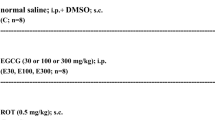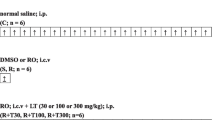Abstract
Parkinson’s disease (PD) is an age-related disease in which dopaminergic neurons in the nigrostriatal pathway are destroyed, resulting in movement and behavioral problems. Oxidative stress and the generation of reactive oxygen species play key roles in neurodegenerative diseases, such as PD. Rotenone (ROT) is a common pesticide that induces oxidative stress. Olive leaves extract (OLE) has antioxidant and neuroprotective effects. Thus, the aim of this study was to investigate the neuroprotective effects of OLE on ROT-induced oxidative stress in the midbrain of a rat model of PD. Ninety-six Wistar rats were randomly divided into the following 6 groups (n = 16 rats/group): Control, Sham, ROT, and 3 ROT + OLE (75, 150, and 300 mg/kg/daily) groups. ROT (2.5 mg/kg/48 h) was injected subcutaneously, and vehicle or OLE was orally administered for 30 days. The animals were then sacrificed, and their brains were removed. Biochemical measures, including the levels of catalase (CAT), glutathione peroxidase (GPx), superoxide dismutase (SOD), and malondialdehyde (MDA), and the number of tyrosine hydroxylase (TH)-positive neurons were determined, and behavioral (rotarod and hanging) tests were conducted. The balance and muscle strength of the OLE (150 and 300 mg/kg)-treated groups were significantly improved. Treatment with OLE prevented the increases in the levels of MDA, significantly improved the SOD, CAT, and GPx levels in the midbrain, and prevented the depletion of the TH-positive neurons. These findings suggested that OLE has neuroprotective properties and that it might be useful for preventing the death of dopaminergic neurons in patients with PD.





Similar content being viewed by others
References
Achour I, Arel-Dubeau A-M, Renaud J, Legrand M, Attard E, Germain M, Martinoli M-G (2016) Oleuropein prevents neuronal death, mitigates mitochondrial superoxide production and modulates autophagy in a dopaminergic cellular model. Int J Mol Sci 17(8):1293
Albarracin SL, Stab B, Casas Z, Sutachan JJ, Samudio I, Gonzalez J, Gonzalo L, Capani F, Morales L, Barreto GE (2012) Effects of natural antioxidants in neurodegenerative disease. Nutr Neurosci 15(2):1–9
Alirezaei M, Kheradmand A, Heydari R, Tanideh N, Neamati S, Rashidipour M (2012) Oleuropein protects against ethanol-induced oxidative stress and modulates sperm quality in the rat testis. Mediterr J Nutr Metab 5(3):205–211
Ayton S, Lei P, Hare DJ, Duce JA, George JL, Adlard PA, McLean C, Rogers JT, Cherny RA, Finkelstein DI (2015) Parkinson's disease iron deposition caused by nitric oxide-induced loss of β-amyloid precursor protein. J Neurosci 35(8):3591–3597
Barbaro B, Toietta G, Maggio R, Arciello M, Tarocchi M, Galli A, Balsano C (2014) Effects of the olive-derived polyphenol oleuropein on human health. Int J Mol Sci 15(10):18508–18524
Bassani TB, Gradowski RW, Zaminelli T, Barbiero JK, Santiago RM, Boschen SL, da Cunha C, Lima MM, Andreatini R, Vital MA (2014) Neuroprotective and antidepressant-like effects of melatonin in a rotenone-induced Parkinson’s disease model in rats. Brain Res 1593:95–105
Blesa J, Trigo-Damas I, Quiroga-Varela A, Jackson-Lewis VR (2015) Oxidative stress and Parkinson’s disease. Front Neuroanat 9:91. https://doi.org/10.3389/fnana.2015.00091
Bradford MM (1976) A rapid and sensitive method for the quantitation of microgram quantities of protein utilizing the principle of protein-dye binding. Anal Biochem 72(2):248–254
Büeler H (2009) Impaired mitochondrial dynamics and function in the pathogenesis of Parkinson's disease. Exp Neurol 218(2):235–246
Cannon JR, Tapias V, Na HM, Honick AS, Drolet RE, Greenamyre JT (2009) A highly reproducible rotenone model of Parkinson's disease. Neurobiol Dis 34(2):279–290
Dekanski D, Selaković V, Piperski V, Radulović Ž, Korenić A, Radenović L (2011) Protective effect of olive leaf extract on hippocampal injury induced by transient global cerebral ischemia and reperfusion in Mongolian gerbils. Phytomedicine 18(13):1137–1143
Dexter D, Carter C, Wells F, Javoy-Agid F, Agid Y, Lees A, Jenner P, Marsden CD (1989) Basal lipid peroxidation in substantia nigra is increased in Parkinson's disease. J Neurochem 52(2):381–389
Dias V, Junn E, Mouradian MM (2013) The role of oxidative stress in Parkinson's disease. J Parkinsons Dis 3(4):461–491
Díaz-Hung M-L, Yglesias-Rivera A, Hernández-Zimbrón LF, Orozco-Suárez S, Ruiz-Fuentes JL, Díaz-García A, León-Martínez R, Blanco-Lezcano L, Pavón-Fuentes N, Lorigados-Pedre L (2016) Transient glutathione depletion in the substantia nigra compacta is associated with neuroinflammation in rats. Neuroscience 335:207–220
Dijkstra AA, Voorn P, Berendse HW, Groenewegen HJ, Rozemuller AJ, Berg WD (2014) Stage-dependent nigral neuronal loss in incidental Lewy body and Parkinson's disease. Mov Disord 29(10):1244–1251
Durlu-Özkaya F, Özkaya MT (2011) Oleuropein using as an additive for feed and products used for humans. J Food Process Technol 2(3):113
El Sedef N, Karakaya S (2009) Olive tree (Olea europaea) leaves: potential beneficial effects on human health. Nutr Rev 67(11):632–638
Esmaeili Mahani S, Kaeidi A (2012) Olive (Olea europaea L.) leaf extract prevents motor deficit in streptozotocin-induced diabetic rats. Physiol Pharmacol 16(2):156–164
Essa M, Braidy N, Bridge W, Subash S, Manivasagam T, Vijayan R, Al-Adawi S, Guillemin G (2014) Review of natural products on Parkinson’s disease pathology. J Aging Res Clin Practice 3:1–8
Fitó M, de la Torre R, Covas MI (2007) Olive oil and oxidative stress. Mol Nutr Food Res 51:1215–1224
García-Villalba R, Larrosa M, Possemiers S, Tomás-Barberán F, Espín J (2014) Bioavailability of phenolics from an oleuropein-rich olive (Olea europaea) leaf extract and its acute effect on plasma antioxidant status: comparison between pre-and postmenopausal women. Eur J Nutr 53:1015–1027
Goth L (1991) A simple method for determination of serum catalase activity and revision of reference range. Clin Chim Acta 196:143–151
Halliday GM, McCann H (2010) The progression of pathology in Parkinson's disease. Ann N Y Acad Sci 1184:188–195
Herrero M-T, Estrada C, Maatouk L, Vyas S (2015) Inflammation in Parkinson’s disease: role of glucocorticoids. Front Neoanat 9:32
Iancu R, Mohapel P, Brundin P, Paul G (2005) Behavioral characterization of a unilateral 6-OHDA-lesion model of Parkinson's disease in mice. Behav Brain Res 162:1–10
Kakkar P, Das B, Viswanathan P (1984) A modified spectrophotometric assay of superoxide dismutase. Indian J Biochem Biophys 21(2):130–132
Kelly MA, Rubinstein M, Phillips TJ, Lessov CN, Burkhart-Kasch S, Zhang G, Bunzow JR, Fang Y, Gerhardt GA, Grandy DK (1998) Locomotor activity in D2 dopamine receptor-deficient mice is determined by gene dosage, genetic background, and developmental adaptations. J Neurosci 18:3470–3479
Khalatbary AR, Ahmadvand H (2012) Neuroprotective effect of oleuropein following spinal cord injury in rats. Neurol Res 34:44–51
Khuwaja G, Khan MM, Ishrat T, Ahmad A, Raza SS, Ashafaq M, Javed H, Khan MB, Khan A, Vaibhav K (2011) Neuroprotective effects of curcumin on 6-hydroxydopamine-induced parkinsonism in rats: behavioral, neurochemical and immunohistochemical studies. Brain Res 1368:254–263
Kumral A, Soluk-Tekkeşin M, Olgaç V, Doğru-Abbasoğlu S, Türkoğlu Ü, Uysal M (2015) Effect of olive leaf extract treatment on doxorubicin-induced cardiac, hepatic and renal toxicity in rats. Pathophysiology 22:117–123
Luccarini I, Dami TE, Grossi C, Rigacci S, Stefani M, Casamenti F (2014) Oleuropein aglycone counteracts Aβ42 toxicity in the rat brain. Neurosci Lett 558:67–72
Martinez M, Brice A, Vaughan J, Zimprich A, Breteler M, Meco G, Filla A, Farrer M, Betard C, Hardy J (2004) Genome-wide scan linkage analysis for Parkinson’s disease: the European genetic study of Parkinson’s disease. J Med Genet 41:900–907
Mehraein F, Talebi R, Jameie B, Joghataie MT, Madjd Z (2011) Neuroprotective effect of exogenous melatonin on dopaminergic neurons of the substantia nigra in ovariectomized rats. Iran Biomed J 15:44–50
Mehraein F, Sarbishegi M, Aslani A (2014) Therapeutic effects of oleuropein on wounded skin in young male BALB/c mice. Wounds 26:83–88
Mohagheghi F, Bigdeli MR, Rasoulian B, Hashemi P, Pour MR (2011) The neuroprotective effect of olive leaf extract is related to improved blood–brain barrier permeability and brain edema in rat with experimental focal cerebral ischemia. Phytomedicine 18:170–175
Mohanasundari M, Srinivasan M, Sethupathy S, Sabesan M (2006) Enhanced neuroprotective effect by combination of bromocriptine and Hypericum perforatum extract against MPTP-induced neurotoxicity in mice. J Neurol Sci 249:140–144
Ohkawa H, Ohishi N, Yagi K (1979) Assay for lipid peroxides in animal tissues by thiobarbituric acid reaction. Anal Biochem 95:351–358
Omar SH (2010) Cardioprotective and neuroprotective roles of oleuropein in olive. Saudi Pharm J 18:111–121
Paglia DE, Valentine WN (1967) Studies on the quantitative and qualitative characterization of erythrocyte glutathione peroxidase. Transl Res 70:158–169
Pasban-Aliabadi H, Esmaeili-Mahani S, Sheibani V, Abbasnejad M, Mehdizadeh A, Yaghoobi MM (2013) Inhibition of 6-hydroxydopamine-induced PC12 cell apoptosis by olive (Olea europaea L.) leaf extract is performed by its main component oleuropein. Rejuvenation Res 16:134–142
Paxinos G, Watson C (2005) The rat brain in stereotaxic coordinates, 5th edn. Academic, San Diego
Pourkhodadad S, Alirezaei M, Moghaddasi M, Ahmadvand H, Karami M, Delfan B, Khanipour Z (2016) Neuroprotective effects of oleuropein against cognitive dysfunction induced by colchicine in hippocampal CA1 area in rats. J Physiol Sci 66:397–405
Rahimmi A, Khosrobakhsh F, Izadpanah E, Moloudi MR, Hassanzadeh K (2015) N-acetylcysteine prevents rotenone-induced Parkinson's disease in rat: an investigation into the interaction of parkin and Drp1 proteins. Brain Res Bull 113:34–40
Santiago RM, Barbieiro J, Lima MM, Dombrowski PA, Andreatini R, Vital MA (2010) Depressive-like behaviors alterations induced by intranigral MPTP, 6-OHDA, LPS and rotenone models of Parkinson's disease are predominantly associated with serotonin and dopamine. Prog Neuropsychopharmacol Biol Psychiatry 34:1104–1114
Sarbishegi M, Mehraein F, Soleimani M (2014) Antioxidant role of oleuropein on midbrain and dopaminergic neurons of substantia nigra in aged rats. Iran Biomed J 18:16–22
Sarrafchi A, Bahmani M, Shirzad H, Rafieian-Kopaei M (2016) Oxidative stress and Parkinson’s disease: new hopes in treatment with herbal antioxidants. Curr Pharm Des 22:238–246
Schwarting R, Bonatz A, Carey R, Huston J (1991) Relationships between indices of behavioral asymmetries and neurochemical changes following mesencephalic 6-hydroxydopamine injections. Brain Res 554:46–55
Song J-X, Sze SC-W, Ng T-B, Lee CK-F, Leung GP, Shaw P-C, Tong Y, Zhang Y-B (2012) Anti-Parkinsonian drug discovery from herbal medicines: what have we got from neurotoxic models? J Ethnopharmacol 139:698–711
Swathi G, Bhuvaneswar C, Rajendra W (2013) Alterations of cholinergic neurotransmission in rotenone induced Parkinson’s disease: protective role of Bacopa monnieri. Int J Pharm Biol Sci 3:286–292
Thakur P, Nehru B (2015) Inhibition of neuroinflammation and mitochondrial dysfunctions by carbenoxolone in the rotenone model of Parkinson’s disease. Mol Neurobiol 51:209–219
Valko M, Leibfritz D, Moncol J, Cronin MT, Mazur M, Telser J (2007) Free radicals and antioxidants in normal physiological functions and human disease. Int J Biochem Cell Biol 39:44–84
Wang L, Geng C, Jiang L, Gong D, Liu D, Yoshimura H, Zhong L (2008) The anti-atherosclerotic effect of olive leaf extract is related to suppressed inflammatory response in rabbits with experimental atherosclerosis. Eur J Nutr 47:235–243
Yu G, Deng A, Tang W, Ma J, Yuan C, Ma J (2016a) Hydroxytyrosol induces phase II detoxifying enzyme expression and effectively protects dopaminergic cells against dopamine-and 6-hydroxydopamine induced cytotoxicity. Neurochem Int 96:113–120
Yu H, Liu P, Tang H, Jing J, Lv X, Chen L, Jiang L, Xu J, Li J (2016b) Oleuropein, a natural extract from plants, offers neuroprotection in focal cerebral ischemia/reperfusion injury in mice. Eur J Pharmacol 775:113–119
Zafar KS, Siddiqui A, Sayeed I, Ahmad M, Salim S, Islam F (2003) Dose-dependent protective effect of selenium in rat model of Parkinson's disease: neurobehavioral and neurochemical evidences. J Neurochem 84:438–446
Zafar K, Inayat-Hussain S, Siegel D, Bao A, Shieh B, Ross D (2006) Overexpression of NQO1 protects human SK-N-MC neuroblastoma cells against dopamine-induced cell death. Toxicol Lett 166:261–267
Acknowledgements
The authors would like to express their appreciation for the support of the deputy vice-chancellor of research of ZAUMS and the Head of the Department of Histology.
Author information
Authors and Affiliations
Contributions
M. Sarbishegi designed and supervised the study, analyzed the data, and wrote the manuscript; EA. Charkhat Gorgich assisted with the modeling and writing of the manuscript. Ozra Khajavi assisted with the modeling and provided technical assistance. Gh. Komeili supervised the behavioral tests. S. Salimi supervised the biochemical analyses. This study was funded by the deputy vice-chancellor of research of ZAUMS (research project No. 7712).
Corresponding authors
Rights and permissions
About this article
Cite this article
Sarbishegi, M., Charkhat Gorgich, E.A., Khajavi, O. et al. The neuroprotective effects of hydro-alcoholic extract of olive (Olea europaea L.) leaf on rotenone-induced Parkinson’s disease in rat. Metab Brain Dis 33, 79–88 (2018). https://doi.org/10.1007/s11011-017-0131-0
Received:
Accepted:
Published:
Issue Date:
DOI: https://doi.org/10.1007/s11011-017-0131-0




